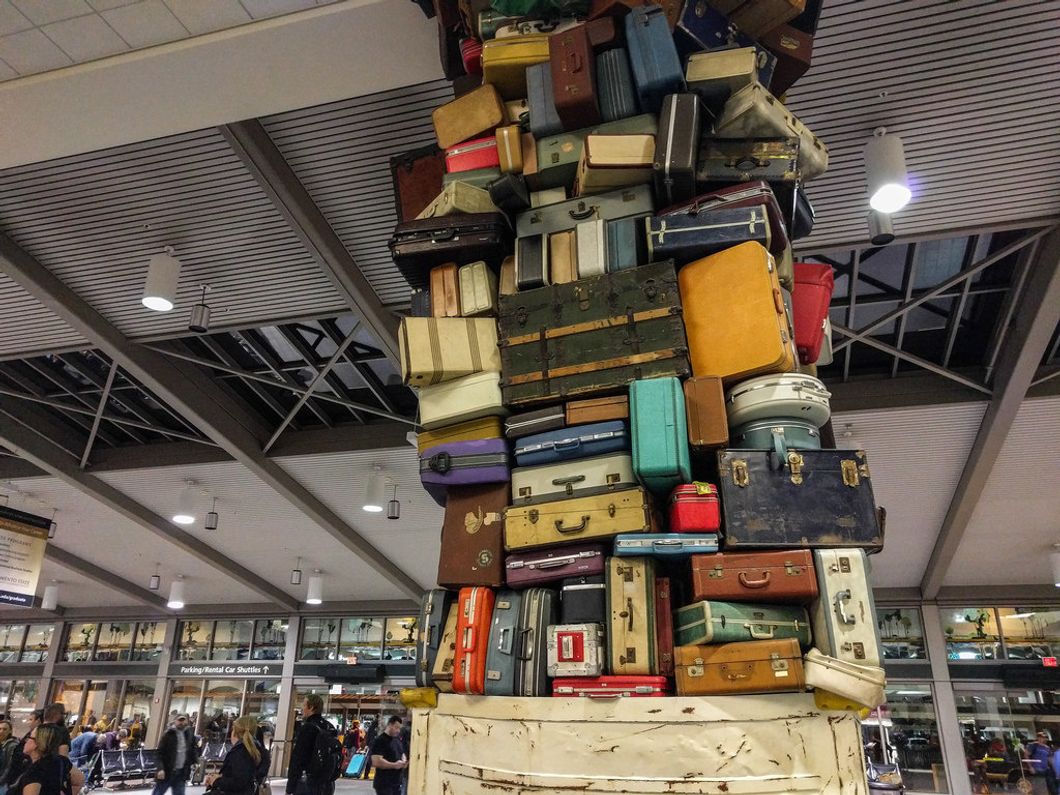As fun as studying abroad is, what isn't all that fun is packing your entire life into a couple of suitcases. It's difficult to determine what to bring for short trips abroad, much less figuring out what you need to spend at least a year in a different country. Many lists on the internet include a lot of items as well, not all of which can fit into your suitcase. I would suggest researching several lists and adjusting them as you see fit.
As I prepare to leave next month for my own study abroad program, my priority is an ease of mind knowing that I won't go over baggage limits. I also bought a luggage scale for this reason. Below, I have included my own packing list along with tips on what I won't be bringing.
Most airlines allow you to carry two bags onto the plane, one personal item, and one carry-on suitcase. In the context of staying long-term, you should make good use of both of these as well as your checked baggage. I'm not about to pretend that minimalism means living out of your purse and small suitcase for over a year.
Personal items:
- Passport with student visa
- Important documents: flight itinerary, transportation tickets, etc.
- State ID/Driver's license
- Cash: At least $300 worth in your host country's currency to get you through the transition to your university and establishing a student bank account. You can order international currency by walking into your bank, which usually offers the lowest conversion rates and fees.
- Debit cards: Check what forms of card are commonly accepted. These are usually Visa and Mastercard. Notify your bank of your travels before you go to avoid your account being frozen.
- Wallet: Whatever wallet you have. RFID wallets and protection sleeves are unnecessary and over-hyped, but if you're feeling a conspiracy-theorist level of paranoid, you can wrap your wallet in tin foil because it does the same thing as an RFID-enabled product.
- Phone and charger: I'd recommend not relying on your phone provider and having an unlocked phone so that you can use a "pay as you go" phone plan in your host country.
- Headphones
- Supplements and prescription drugs - Supplements can be carried in plastic zipped bags with labels to save space taken up by bottles. Check the legal status of your prescription drugs in your host country, as some may require a doctor's letter and/or your prescription.
- 1-quart plastic zipped bag - This is TSA compliant and eliminates the need to buy a specific bag for that purpose. Fill this with travel sized shampoo, conditioner, body wash, hand sanitizer, toothpaste, lip balm, lotion, moisturizer, face wash, and any gels or liquid medicines. Liquids and gels can't exceed 3.4 ounces per bottle, even if the bottle is partially empty, and must all fit in the bag. Alternatively, buy empty travel bottles at Wal-Mart or Target and fill them with things from home. This eliminates the need to rush out to a store right away after arrival.
- Non-essentials: mini tissues, earplugs, travel pillow, painkillers, sleep aids, power bank, book/e-reader, lip balm, journal, sunglasses, pens, and a plane headphone jack adapter (the provided headphones are always terrible and not all headphone cables fit the tiny headphone jack).
Carry-on Bag
This list is for those absolute essential and valuable items that you must have on entering the country, in case your airline loses your checked baggage (aka the factor that keeps me up at night). Consider buying a TSA-approved lock to keep your stuff safe in the overhead compartments while you sleep on your flight.
- Laptop: It's uncomfortable and unnecessary to have this at your seat in your personal bag when there's no WiFi. If you're a student, you're probably flying in economy class which has limited space. Take it from me, a chronic multitasker, you will not get anything productive done on the plane. Sleep, watch a movie or read a book.
- Travel outlet adapters (2-3): These an absolute necessity. Also, buy laptop adapter cables for the power supply (the part between the box and the wall) online before you leave.
- Hairbrush/comb
- A change of clothes, especially items you would miss if they were lost.
- Sentimental items
- Valuables
Checked Baggage
When considering what clothes to bring, research the weather of your host country. It won't make much sense to bring shorts, tank tops, and swimsuits to a place that never gets warm, or winter wear to a place that doesn't get cold
- Underwear (14 or depending on how often you want to do laundry)
- Socks (14 pairs)
- Short sleeve shirts (5-7)
- Long sleeve shirts (3-5)
- Tank tops (2-3)
- Sweaters (3-5)
- Heavy coat
- Hoodie
- Gloves
- Scarf
- Flip flops and/or shower shoes
- Boots
- Sneakers
- Pajamas
- 1 set of workout clothes (optimistically)
- Pants (3-4 pairs)
- Shorts
- Swimsuit
- Sunhat
- Small umbrella
- Backpack/purse (preferably a theft-proof one with metal reinforcements in the straps)
Don't Pack...
These things include the items you can buy in your host country. These things include notebooks, binders, bed sheets, duvet insert and cover, pillows, bath towels, beach towels, linen sprays, stain removers, laundry detergent, as well as full-sized items such as shampoo, conditioner, body wash, hand soap, dish soap.
Some lists suggest packing extra things that you may not need to pack and can certainly buy later such as thermal underwear, wool socks, a sleeping bag, undershirts, belts, water-resistant coat, and a formal outfit.
Items you do not need and should probably not bring include any kitchen utensils, American snacks, unsentimental decorative items, and organization items including shoe racks and packing cubes. Also do not bring a hair dryer, straightener, or curling iron. American products can fry circuits with how much power they use.
Happy packing and safe travels!
















